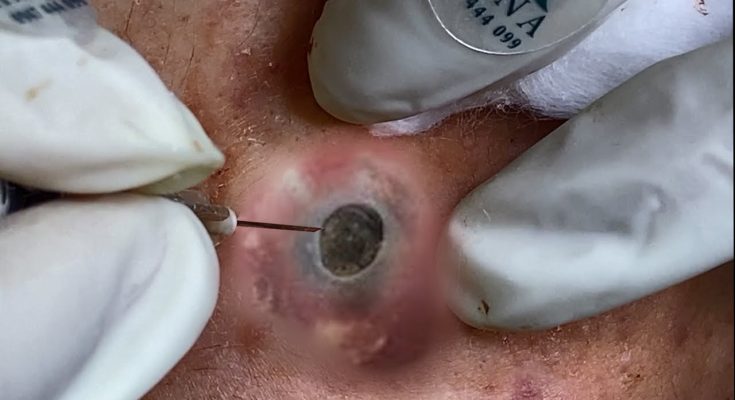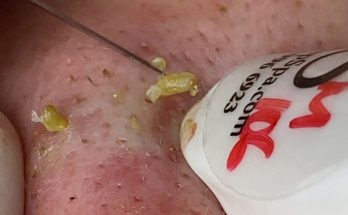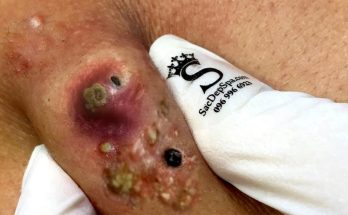Massive Blackhead Extraction: The Process and Insights
Blackheads, or open comedones, are a common form of acne that form when hair follicles become clogged with oil, dead skin cells, and other debris. They are typically small, dark spots on the skin, often appearing on the face, particularly around the nose, chin, and forehead. While blackheads are generally harmless, they can be a source of frustration for those dealing with them, especially when they become larger and more stubborn. Massive blackheads, which can be especially difficult to extract, often require a more careful approach.
What Causes Blackheads?
Blackheads form when excess sebum (oil produced by the sebaceous glands) combines with dead skin cells and becomes trapped in a hair follicle. The opening of the pore remains open, allowing the contents to oxidize when exposed to air, which causes the characteristic dark color. In some cases, blackheads can grow to an unusually large size, becoming a source of both aesthetic concern and potential discomfort. Factors that contribute to blackhead formation include hormonal fluctuations, excessive oil production, poor skincare habits, environmental factors, and the use of comedogenic (pore-clogging) products.
The Importance of Safe Extraction
While extracting blackheads can seem like a tempting solution, especially for larger ones, it’s important to be cautious. The process of removing massive blackheads improperly can lead to skin damage, including scarring, infections, and further breakouts. The skin surrounding blackheads is often sensitive, and pressing too hard or using dirty tools can introduce bacteria, exacerbating the problem.
To ensure safe and effective blackhead extraction, it’s recommended to either visit a dermatologist or licensed esthetician or perform the procedure with great care at home using appropriate techniques.
The Extraction Process
1. Preparation: Before attempting any extraction, it’s crucial to prepare your skin properly. Start by cleansing your face with a gentle cleanser to remove dirt and excess oils. Next, apply a warm compress or steam your face for several minutes to help open the pores. The heat softens the skin, making it easier to extract the blackhead without applying too much pressure.
2. Softening the Blackhead: After steaming or applying a warm compress, the next step is to use a pore-opening product. A mild exfoliating product, such as a chemical exfoliant with salicylic acid, can help dissolve the debris within the pore. This step is crucial for stubborn or deep-rooted blackheads, as it aids in loosening the buildup.
3. Extraction: For large or massive blackheads, it’s often best to use a comedone extractor tool, which is a small, looped instrument designed to safely extract debris from the pore. Apply gentle, even pressure on the skin surrounding the blackhead—if it doesn’t come out with minimal force, stop and consider other treatments. Forcing the extraction can cause the skin to tear or become inflamed.
4. Aftercare: Once the blackhead is removed, it’s important to calm the skin and prevent infection. Apply a soothing toner or antiseptic to the affected area. Avoid touching your face, as this can transfer bacteria to the skin. To minimize the risk of future blackheads, incorporate a regular skincare routine that includes cleansing, exfoliation, and moisturizing to maintain healthy skin.
Potential Risks and Side Effects
Extracting massive blackheads, especially without the right tools or technique, can have adverse effects. Improper extraction can lead to skin irritation, inflammation, and even scarring. If blackheads are deeply embedded in the skin, trying to remove them at home could lead to the formation of cysts or more severe forms of acne. Furthermore, if you have sensitive skin, the extraction process could cause redness, swelling, or damage to the skin barrier.
Professional Help
While extracting blackheads at home can provide temporary relief, seeking professional help is often the best solution for more stubborn or severe cases. Dermatologists and estheticians use specialized tools and techniques to ensure extractions are performed safely, minimizing the risk of damage and infection. Additionally, they can offer personalized skincare advice to help prevent future blackheads.
Conclusion
Massive blackhead extraction, though a tempting solution for clear skin, requires care and precision. Whether performed at home or by a professional, it’s essential to follow the proper steps to ensure the skin remains healthy. Consistent skincare habits and seeking professional help when necessary can lead to lasting results and a smoother complexion.




